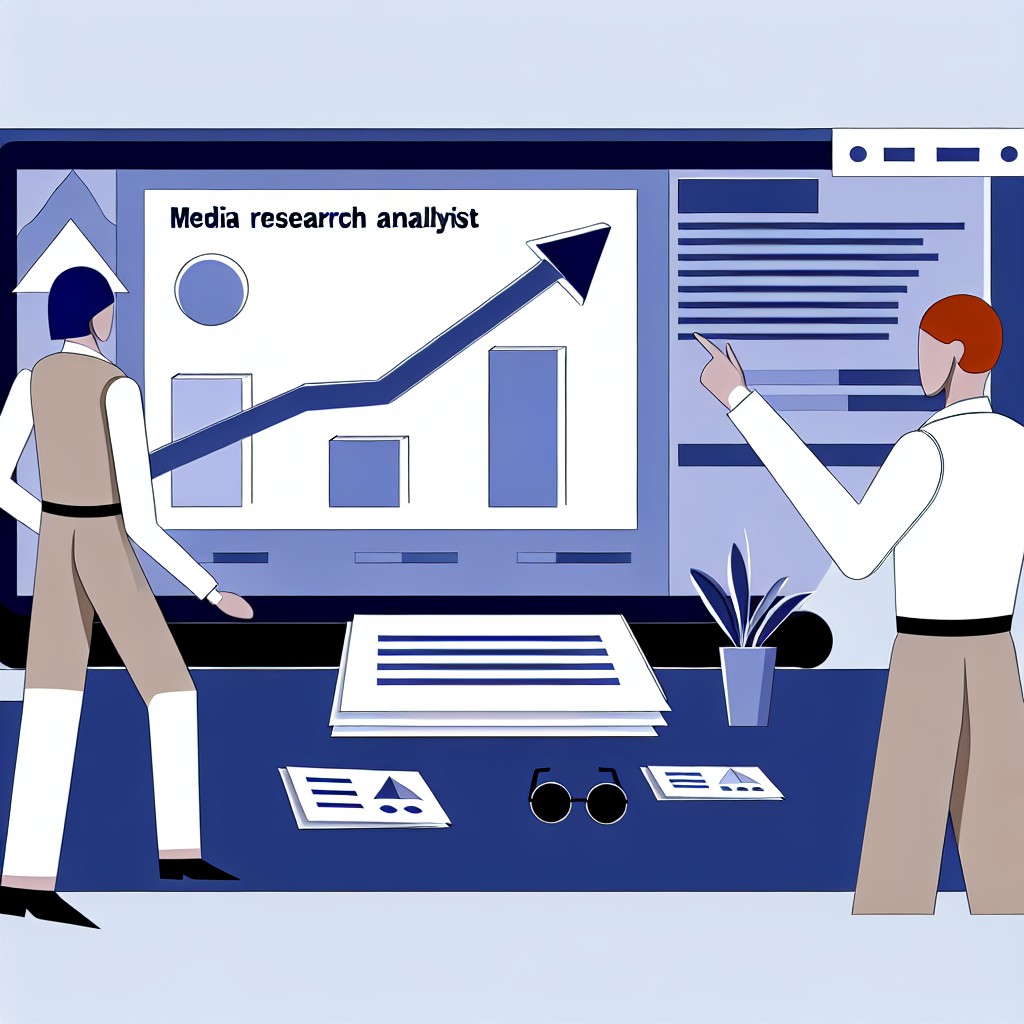Introduction
A Media Research Analyst is a professional who analyzes media trends and consumer behaviors.
They provide critical insights that drive marketing strategies.
Their main goal is to understand how media impacts audience perception and behavior.
Media Research Analysts collect data from various sources.
This data helps businesses understand market dynamics.
They use statistical tools to analyze audience metrics and engagement levels.
By doing so, they determine which media channels are most effective.
Key responsibilities of a Media Research Analyst include data collection, trend analysis, and reporting.
They often work closely with marketing teams to identify target audiences.
They evaluate the effectiveness of marketing campaigns through comprehensive data analysis.
Additionally, they conduct surveys and focus groups.
This research helps them garner qualitative insights about audience preferences.
They translate complex data into actionable recommendations for marketing strategies.
KPIs are essential to the Media Research Analyst’s role.
They measure the success of media campaigns and marketing initiatives.
Analysts rely on KPIs to track performance against objectives.
Their analysis informs whether strategies need adjustments or improvements.
Common KPIs for Media Research Analysts include audience reach, engagement rates, and conversion metrics.
These indicators help gauge the effectiveness of various media channels.
They also measure the impact of specific campaigns on overall brand awareness.
Transform Your Career Today
Unlock a personalized career strategy that drives real results. Get tailored advice and a roadmap designed just for you.
Start NowMedia Research Analysts utilize KPIs to provide valuable insights.
They highlight trends that can influence future marketing efforts.
By analyzing these indicators, they assist businesses in making informed decisions.
Understanding and applying KPIs allows Media Research Analysts to drive success.
Their expertise ensures that media strategies align with overall business goals.
Ultimately, they play a crucial role in enhancing a brand’s market position.
As businesses increasingly rely on media to reach their target audiences, the role of a Media Research Analyst becomes vital.
Analysts provide valuable insights that shape media strategies and campaigns.
Understanding their responsibilities helps organizations recognize their importance in driving success.
Researching and Analyzing Data Related to Media Trends
Media Research Analysts conduct extensive research to identify trends in various media platforms.
Their work focuses on gathering quantitative and qualitative data related to audience engagement, advertising performance, and content consumption.
Key activities include:
- Monitoring Industry Trends: Analysts track emerging media trends, including shifts in consumer behavior and advances in technology.
- Utilizing Analytical Tools: They employ various analytical tools to gather data from social media, websites, and traditional media.
- Gathering Audience Insights: Understanding demographic information helps analysts target specific audience segments effectively.
- Evaluating Media Channels: Analysts assess the effectiveness of different media channels to find the most impactful ones.
- Collecting Competitive Data: They analyze competitors’ media efforts to identify successful strategies and areas for improvement.
By meticulously collecting relevant data, analysts can paint a comprehensive picture of the media landscape.
This information is foundational for making informed decisions that drive marketing efforts.
Identifying Patterns and Insights
Once analysts gather substantial data, they focus on identifying patterns that can provide actionable insights.
This process includes several techniques:
- Data Segmentation: Analysts segment data by demographics, geography, and other factors to explore differences in consumer behavior.
- Trend Analysis: They identify trends by comparing historical data with current performance metrics.
- Consumer Behavior Patterns: Understanding how consumers interact with media helps analysts predict future behavior.
- Sentiment Analysis: Analysts assess public sentiment towards a brand using social media and survey data.
- Performance Metrics: They evaluate campaign performance using KPIs to determine overall effectiveness.
Through these methods, analysts derive insights that can sharpen media strategies.
The findings enable organizations to refine their approaches and better connect with their audiences.
Collaboration Between Media Research Analysts and Media Planners
Collaboration forms an essential aspect of a Media Research Analyst’s role.
Working closely with media planners and buyers ensures alignment and optimization throughout the campaign process.
Transform Your Career Today
Unlock a personalized career strategy that drives real results. Get tailored advice and a roadmap designed just for you.
Start NowKey collaboration elements include:
- Strategic Alignment: Analysts align their insights with the broader goals set by media planners.
- Data-Driven Recommendations: Working together, analysts provide recommendations based on their research, helping planners refine media purchases.
- Performance Monitoring: Analysts and planners regularly assess campaign performance, making adjustments as necessary based on real-time data.
- Feedback Loop: Effective communication enables a feedback mechanism where planners offer insights about practical applications of research findings.
- Reporting and Presentations: Analysts prepare reports and presentations to share insights with stakeholders effectively.
This collaboration not only enhances the effectiveness of campaigns but also maximizes return on investment (ROI) for media spend.
Maintaining Expertise Through Continuous Learning
The media landscape is always evolving, and continuous learning is crucial for Media Research Analysts.
Staying updated involves:
- Following Industry News: Analysts subscribe to industry newsletters and publications to understand current trends.
- Networking with Professionals: Engaging with peers through conferences and workshops fosters knowledge sharing.
- Skills Development: Embracing new analytical tools and software enhances research capabilities.
- Participating in Webinars: Attending webinars provides insights from experts about the latest media research techniques.
- Seeking Certifications: Pursuing relevant certifications can enhance credibility and skills in data analytics.
By investing time and effort into continuous learning, analysts can maintain their competitive edge.
This dedication helps them provide better support to their organizations.
The Strategic Value of Media Research Analysts
The role of a Media Research Analyst extends beyond simply collecting data.
Their deep understanding of media trends and consumer behavior directly influences the success of marketing efforts.
By researching and analyzing data, identifying insights, and collaborating effectively, these professionals add immense value.
Organizations that recognize and utilize the skills of Media Research Analysts position themselves at the forefront of effective media strategies.
As the media landscape continues to change, the importance of these specialists will only grow.
Their ability to turn data into actionable intelligence is crucial in today’s data-driven world.
Companies must prioritize media research analysis to enhance their media strategies and ultimately reach their business objectives.
Key Performance Indicators and Their Role in Media Research
Key Performance Indicators (KPIs) play a vital role in media research.
They serve as quantifiable metrics that evaluate the success of media campaigns.
A KPI is essentially a measurable value that demonstrates how effectively a company achieves key business objectives.
In the context of media research, KPIs provide clear insights into the performance of various campaigns.
By analyzing these metrics, media research analysts can better understand the impact of their media strategies.
Definition of KPIs in the Context of Media Research
Key Performance Indicators in media research are specific measurements used to assess campaign performance.
These indicators help to quantify the effectiveness of media initiatives.
Transform Your Career Today
Unlock a personalized career strategy that drives real results. Get tailored advice and a roadmap designed just for you.
Start NowMedia research analysts utilize KPIs to gauge success.
This makes it easier to make informed decisions.
The definition of KPIs may vary based on objectives.
However, they consistently provide insight into performance against set goals.
Ways KPIs Measure the Success and Effectiveness of Media Campaigns
Measuring the success of media campaigns is crucial for ensuring resources are utilized efficiently.
KPIs assist by offering tangible data that illustrate campaign outcomes.
They also guide analysts in determining whether media strategies align with organization objectives.
- KPIs facilitate data-driven decisions by providing a clear overview of a campaign’s performance.
- They allow for real-time analysis, helping teams to make adjustments swiftly.
- KPIs provide benchmarks that can be compared across campaigns, enhancing learning and optimization.
- They reveal insights into audience engagement, allowing for targeted improvements in future campaigns.
By maximizing the effectiveness of media strategy, KPIs contribute significantly to achieving organizational goals.
They enable analysts to identify what works well and what requires change.
Common KPIs Used by Media Research Analysts
Media research analysts rely on specific KPIs to track campaigns effectively.
Here are some prevalent examples of such KPIs.
- Reach: This measures the total number of unique users who see a campaign.
- Impressions: Impressions quantify the total number of times an advertisement is displayed, regardless of clicks.
- Engagement Rate: This indicates how users interact with content, often measured through likes, shares, and comments.
- Click-Through Rate (CTR): CTR measures how often people click on an ad after seeing it.
- Conversion Rate: This indicates the percentage of users who take a desired action such as making a purchase.
- Cost per Acquisition (CPA): CPA measures the total cost spent acquiring a customer through a specific campaign.
- Return on Investment (ROI): This calculates the revenue generated against the cost of the marketing investment.
- Session Duration: This KPI tracks how long visitors remain engaged with content.
These metrics give analysts tangible data to evaluate campaigns effectively.
By aligning media strategies with these KPIs, teams can improve performance and drive success.
Significance of KPIs for Informed Media Strategy Development
Key Performance Indicators are essential tools for media research analysts.
They not only define the success of media campaigns but also guide strategic decisions.
By establishing a clear framework for measurement, KPIs pave the way for informed planning.
This enables media teams to focus on impactful areas and optimize their strategies for continued success.
Explore Further: How to Start a Career as an Event Planner
Setting clear objectives is essential for the success of media campaigns.
One effective framework for establishing these objectives is the SMART criteria.
Transform Your Career Today
Unlock a personalized career strategy that drives real results. Get tailored advice and a roadmap designed just for you.
Start NowSMART stands for Specific, Measurable, Achievable, Relevant, and Time-bound.
This framework helps ensure that the goals set for the campaign are clear and reachable.
What are SMART Goals
SMART goals possess five distinct characteristics:
- Specific: The goal should clearly define what is to be achieved.
- Measurable: The goal must include criteria to track progress and determine success.
- Achievable: The goal should be realistic and attainable within the available resources.
- Relevant: The goal must align with broader business objectives and strategies.
- Time-bound: The goal should have a specific timeline for completion.
By implementing SMART goals, media research analysts can create structured plans that drive campaign success.
These goals serve as a foundation for evaluating performance metrics and adjusting strategies accordingly.
How Media Research Analysts Use SMART Goals
Media research analysts utilize SMART goals to track progress throughout campaign execution.
They employ various strategies:
- Identifying Key Outcomes: Analysts pinpoint specific results they aim to achieve. For example, increasing website traffic by 30% within three months is specific and time-bound. This clarity allows teams to focus on high-impact activities.
- Data Collection and Analysis: Analysts gather data at multiple campaign stages. Measurable goals like achieving 5,000 new followers by the end of a month enable them to track social media growth effectively.
- Resource Allocation: Understanding achievable goals helps analysts allocate resources efficiently. When campaign objectives align with capabilities, teams can prioritize tasks and avoid wasting time.
- Continuous Monitoring: Media research analysts regularly review progress toward SMART goals. This ongoing assessment allows for quick adjustments if campaigns aren’t on track, ensuring objectives remain relevant.
- Final Evaluation: At the end of a campaign, analysts evaluate overall success using these goals. They compare initial objectives against actual results to determine effectiveness.
Aligning KPIs with SMART Goals for Better Campaign Management
Key Performance Indicators (KPIs) reflect the success of media campaigns.
Aligning KPIs with SMART goals is vital for accurate measurement.
Here’s how this alignment enhances campaign management:
- Clarity of Purpose: When KPIs are linked to clear SMART goals, the purpose of each metric becomes evident. For example, tracking lead conversion rates in relation to a goal of generating 100 qualified leads makes the metric meaningful.
- Focused Strategies: Analysts can develop precise strategies based on defined KPIs. If a campaign goal is to improve customer engagement, KPIs like average session duration or bounce rate can be targeted.
- Accountability: Each team member remains accountable when KPIs tie directly to SMART goals. Accountability drives engagement and encourages team members to prioritize their efforts accordingly.
- Proactive Adjustments: When KPIs fall short, analysts can identify issues early. Timely adjustments are possible with measurable goal tracking, leading to better outcomes.
- Informed Decision-Making: SMART goals support informed decision-making. Media research analysts can adjust tactics based on whether primary KPIs indicate progress toward the goal.
Advantages of Using SMART Goals in Media Campaigns
Establishing SMART goals within media campaigns offers several advantages:
- Enhanced Focus: Teams concentrate on key objectives rather than disseminating efforts across ambiguous targets. With SMART goals, the campaign’s direction becomes clearer.
- Improved Team Communication: A universal understanding of what constitutes success fosters better communication. Teams can discuss progress, identify challenges, and collaborate on solutions more effectively.
- Greater Efficiency: By targeting specific and measurable objectives, teams avoid wasting resources. SMART goals provide a basis for evaluating the most effective strategies, ensuring resources only go towards impactful areas.
- Benchmarking Progress: SMART goals create benchmarks for evaluating progress over time. Analysts can assess performance against parameters, adjusting tactics based on results.
- Increased Engagement: Employees often feel more motivated when they understand the objectives. Knowing the goals are SMART can inspire teams to work harder towards achieving them.
Common Challenges When Establishing SMART Goals
Despite the benefits, creating SMART goals poses challenges:
- Cultural Resistance: Some organizations struggle with changing their goal-setting processes. Resistance often arises from established practices that prioritize traditional metrics.
- Over-Complexity: Teams may overcomplicate the SMART process, leading to confusion. Simplicity often results in clearer objectives and better performance.
- Shifting Business Needs: Market conditions often change, requiring flexibility. Analysts might need to revise goals as new challenges arise.
- Resource Limitations: Achievable goals can be hampered by limited resources. Organizations must assess their capacity to avoid setting unrealistic goals.
Setting SMART goals significantly impacts the success of media campaigns.
By aligning KPIs with these goals, media research analysts can create a structured approach to measuring and optimizing performance.
Understanding the principles of SMART goals empowers analysts to drive campaigns effectively.
This structured methodology ultimately leads to greater success in achieving marketing objectives.
Utilizing these frameworks ensures campaigns remain focused, accountable, and adaptable in today’s dynamic media landscape.
Explore Further: Press Secretary’s Role in Public Health Communication
As media research analysts, professionals must analyze and interpret data effectively.
They play a crucial role in determining the success of media campaigns.
Transform Your Career Today
Unlock a personalized career strategy that drives real results. Get tailored advice and a roadmap designed just for you.
Start NowBy collecting and organizing data, analysts help clients make informed decisions.
This section delves into the process of analyzing and interpreting data.
It focuses on the key steps involved.
Collecting and Organizing Data from Various Sources
Data collection is the foundation of effective analysis.
Analysts gather information from multiple sources to create a comprehensive picture of media performance.
They rely on both primary and secondary data.
- Primary Data: This type of data is collected directly from the source.
- Surveys, interviews, and focus groups are common methods.
- Analysts design these tools to target specific audience segments.
- Secondary Data: This data comes from existing sources.
- Analysts may use market reports, academic research, and industry publications.
- Such resources provide context and background for their findings.
- Social Media Analytics: Analysts utilize tools to collect data from social media platforms.
- They track engagement metrics like likes, shares, and comments.
- This data helps understand audience sentiment and behavior.
- Website Analytics: Tools like Google Analytics allow analysts to monitor website traffic.
- Metrics like page views, bounce rates, and conversion rates offer insights into user behavior.
- Audience Measurement Tools: These tools, such as Nielsen ratings, provide valuable insights into television viewership.
- They help assess the reach and effectiveness of advertising campaigns.
Once data is collected, analysts organize it systematically.
They create databases or spreadsheets, ensuring data is easy to access and navigate.
Having organized data enhances the analysis process and makes interpretation easier.
Utilizing Data Visualization Tools and Software to Present Findings
Data visualization plays a vital role in the analysis process.
Analysts use various tools to convert complex data into accessible visual formats.
Effective visualization helps stakeholders understand findings quickly.
- Graphs and Charts: Analysts convert numerical data into line graphs, bar charts, and pie charts.
- These visual representations make trends and comparisons apparent.
- Dashboards: Analysts create interactive dashboards to present real-time data.
- Such tools allow stakeholders to engage with the data directly, encouraging exploration.
- Infographics: Informative visuals summarize key findings.
- Infographics combine text, images, and data to convey messages clearly.
- Heat Maps: Analysts use heat maps to depict audience engagement.
- These maps highlight areas of interest, allowing better understanding of user behavior.
- Presentation Software: Tools like PowerPoint assist in conveying findings.
- Analysts use these platforms to create engaging presentations for stakeholders.
Choosing the right visualization tool is crucial.
Each tool serves different purposes and audiences.
Analysts must tailor their visualizations to the needs and preferences of stakeholders.
Interpreting Data to Draw Actionable Insights
Interpreting data is perhaps the most critical step for analysts.
They must extract meaningful insights from data to guide media strategies.
This process demands careful analysis and critical thinking.
- Identifying Trends: Analysts look for patterns in the data.
- They track changes over time and compare different datasets.
- Identifying trends helps forecast future outcomes.
- Understanding Audience Behavior: Analysts interpret data to gain insights into audience preferences.
- They focus on factors such as demographics and psychographics.
- Measuring Success: Analysts evaluate the effectiveness of media campaigns.
- They compare campaign performance against established KPIs to assess success.
- Making Recommendations: Based on their findings, analysts recommend actionable strategies.
- These recommendations may include shifting advertising budgets, targeting different audiences, or adjusting messaging.
- Communicating Insights: Analysts must communicate their findings clearly to stakeholders.
- They prepare reports that summarize key insights and strategies.
Effective interpretation of data requires the ability to connect dots.
Analysts must synthesize information from multiple sources and identify correlations.
Transform Your Career Today
Unlock a personalized career strategy that drives real results. Get tailored advice and a roadmap designed just for you.
Start NowThey should also be aware of potential biases that could influence findings.
The Role of Data Analysis in Enhancing Media Strategies
Analyzing and interpreting data is a multifaceted process in media research.
It starts with collecting diverse data sources and organizing it systematically.
Through data visualization, analysts present their findings in comprehensible formats.
Finally, interpreting that data leads to actionable insights that shape effective media strategies.
Media research analysts play a pivotal role in helping organizations navigate the evolving media landscape.
Their efforts lead to informed decision-making and ultimately drive campaign success.
By adhering to these principles, analysts contribute to the growth and effectiveness of their clients’ media initiatives.
Uncover the Details: Exploring Different Content Formats: Blogs, Vlogs, and More

In any media campaign, monitoring and measuring your Key Performance Indicators (KPIs) are vital for determining success.
Effective monitoring helps in aligning your strategies with your goals.
It allows you to adjust tactics in real time, ensuring resources are allocated efficiently.
Here is a closer look at how to effectively monitor and measure KPIs in a media research context.
Establishing Benchmarks for KPIs Based on Campaign Objectives
Before any campaign launches, you must establish clear benchmarks.
Benchmarks serve as reference points for evaluating the performance of your KPIs throughout the campaign.
To set these benchmarks effectively, consider the following factors:
- Define Clear Objectives: Have specific, measurable, achievable, relevant, and time-bound (SMART) objectives.
- Analyze Historical Data: Look at past campaign performance for similar initiatives.
- Industry Standards: Research industry benchmarks in your niche.
- Audience Insights: Consider your target audience’s behavior.
- Resource Availability: Factor in your team’s resources and capabilities.
Once you have established your benchmarks, continuously revisit and refine them as needed.
Flexibility is key in a dynamic media landscape.
Adjust benchmarks according to any changes in campaign strategy or external conditions.
Regularly Tracking KPIs Throughout the Campaign
Regular tracking is essential for understanding how well your campaign is performing.
Transform Your Career Today
Unlock a personalized career strategy that drives real results. Get tailored advice and a roadmap designed just for you.
Start NowImplement a systematic approach to tracking your KPIs over the campaign duration.
Here are some tips to effectively track your KPIs:
- Utilize Analytics Tools: Take advantage of analytical tools like Google Analytics, HubSpot, or specialized media monitoring platforms.
- Schedule Regular Reviews: Set a timeline for periodic reviews of your KPIs.
- Document Findings: Keep a log of your findings during reviews.
- Compare Against Benchmarks: Always compare your data against established benchmarks.
- Engage Your Team: Share KPI results with your team.
Tracking KPIs is not a one-time process.
Continuous tracking provides insights into your campaign’s performance and informs necessary course corrections.
Analyzing KPI Data to Make Data-Driven Decisions for Optimization
Data analysis plays a crucial role in optimizing your media campaigns.
After tracking your KPIs, the next step is to analyze this data effectively.
Consider these strategies for data analysis:
- Identify Trends: Look for trends within your KPI data.
- Segment Your Data: Break down your data by demographics, channels, or other relevant categories.
- Correlate KPIs: Analyze relationships between different KPIs.
- Utilize Visualization Tools: Use charts, graphs, and dashboards to visualize your data.
- Continuous Learning: Stay updated with the latest analytics trends.
After thorough analysis, identify actionable insights.
Formulate a plan to implement changes based on these insights.
Optimization should be a key focus of your ongoing analysis.
Best Practices for Maximizing Campaign Effectiveness Through KPI Monitoring
Monitoring and measuring KPIs is an ongoing process that requires attention to detail and adaptation.
Establishing clear benchmarks is essential to gauge success accurately.
Regular tracking ensures that you stay informed about the campaign’s performance and can make timely adjustments.
Finally, thorough data analysis allows for the extraction of meaningful insights that drive optimization.
By adhering to these best practices, you will be well-equipped to maximize the effectiveness of your media campaigns and achieve your objectives.
Your approach to KPIs can significantly influence the overall success of your media strategies.
Find Out More: How to Plan Themed Events Creatively
Effective reporting and presentation of findings are vital components in the role of a media research analyst.
These analysts collect data, analyze trends, and assess performance metrics.
They must convey their insights and recommendations to stakeholders effectively.
Transform Your Career Today
Unlock a personalized career strategy that drives real results. Get tailored advice and a roadmap designed just for you.
Start NowThis section will discuss the importance of creating comprehensive reports, presenting findings concisely, and utilizing data visualization tools.
Creating Comprehensive Reports
Compiling a detailed report is crucial in summarizing performance metrics.
A well-structured report allows stakeholders to understand the status of KPIs clearly.
Here are key elements that should be included in KPI reports:
- Executive Summary: Offer a brief overview of the findings, including the primary insights.
- KPI Metrics: Identify and define each KPI.
- Methodology: Describe the method used for data collection and analysis.
- Findings and Trends: Summarize the key findings, highlighting trends and patterns identified in the data.
- Impact Analysis: Discuss the implications of the findings on business operations.
- Recommendations: Based on the analysis, provide actionable recommendations.
- Appendices: Include any raw data or supplementary information.
Offer a brief overview of the findings, including the primary insights.
This summary should cater to stakeholders who may not delve into the data but need an understanding of the general outcomes.
Explain how each KPI relates to the organization’s goals and performance.
Include both quantitative and qualitative data to provide comprehensive insights.
This transparency builds trust and allows stakeholders to assess the reliability of the findings.
Use bullet points or tables to make complex information accessible.
How do these insights align with strategic initiatives?
Address areas of concern and growth opportunities.
These suggestions should guide stakeholders on the next steps, aligning KPIs with strategic goals.
This section gives stakeholders the option to explore detailed data if they desire.
By ensuring comprehensive reports contain these components, media research analysts facilitate informed decision-making.
Stakeholders will appreciate clarity and depth in understanding the performance metrics.
Presenting Findings to Stakeholders and Clients
Once the reports are compiled, analysts must present their findings.
An impactful presentation enhances stakeholder engagement and comprehension.
Here’s how to present findings effectively:
- Understand Your Audience: Tailor your presentation to suit the audience.
- Structure Your Presentation: Follow a logical structure.
- Practice Clear Communication: Use simple language.
- Focus on Key Messages: Highlight key insights.
- Invite Questions: Encourage stakeholder inquiries throughout your presentation.
By adhering to these practices, analysts will enhance the effectiveness of their presentations.
Transform Your Career Today
Unlock a personalized career strategy that drives real results. Get tailored advice and a roadmap designed just for you.
Start NowPresenting data comprehensively fosters understanding and facilitates strategic discussions.
Utilizing Data Visualization Tools
Data visualization tools play a significant role in effective data presentation.
These tools help transform complex data sets into visuals that enhance comprehension.
Here are essential aspects to consider when utilizing data visualization:
- Select the Right Tools: Choose visualization tools that align with your data and reporting needs.
- Choose Appropriate Visuals: Utilize charts, graphs, and infographics.
- Keep It Simple: Avoid cluttered visuals.
- Use Color Strategically: Employ contrasting colors to differentiate data points.
- Interactive Elements: Consider incorporating interactive elements in presentations.
Integrating data visualization tools not only clarifies insights but also enhances stakeholder engagement.
Well-executed visuals capture attention and facilitate understanding.
Critical Role of Effective Reporting and Presentation
Reporting and presenting findings is a significant responsibility for media research analysts.
Comprehensive reports provide essential details that inform strategic decisions.
Clear presentations enhance stakeholder understanding and foster meaningful discussions.
Utilizing data visualization tools enriches the presentation experience and aids comprehension.
By mastering these elements, analysts can deliver actionable insights that drive success.
The ability to communicate data effectively is invaluable in today’s data-driven landscape.
Role of KPIs in Media Strategy Evaluation
Key Performance Indicators (KPIs) play a critical role for Media Research Analysts.
Analysts use KPIs to measure and track media strategy effectiveness.
These metrics provide valuable insights on audience engagement and campaign performance.
Identifying Patterns and Enhancing Media Effectiveness
KPIs help analysts identify trends and patterns within media data.
By monitoring reach, impressions, and conversion rates, analysts improve media effectiveness.
These indicators also enable campaign adjustments for better results.
As a result, KPIs guide analysts to make data-driven decisions.
Importance of Data Analysis and Interpretation
Data analysis and interpretation are central to optimizing media strategies.
Transform Your Career Today
Unlock a personalized career strategy that drives real results. Get tailored advice and a roadmap designed just for you.
Start NowAnalysts dissect complex data sets to extract actionable insights.
They evaluate what succeeds and what fails, enabling informed adjustments.
This data-focused method ensures media campaigns resonate with target audiences.
Adapting to Evolving Media Research Landscape
The media research landscape is constantly evolving with new technologies and platforms.
Analysts must implement adaptive strategies to keep pace with these changes.
Continuous learning is essential for maintaining expertise in media research.
Analysts should embrace new tools and methodologies to refine their skills.
Professional Development and Networking Opportunities
Numerous development opportunities exist within the media research industry.
Online courses, workshops, and conferences enhance analysts’ knowledge and expertise.
Engaging with professional networks exposes analysts to diverse perspectives.
These interactions often spark innovative approaches to media analysis.
Strategic Emphasis on KPIs and Continuous Growth
KPIs remain indispensable for evaluating media performance effectively.
They focus attention on data analysis and interpretation throughout campaigns.
Prioritizing continuous learning helps analysts thrive in this dynamic field.
Staying informed positions analysts to lead media strategy optimization.
Additional Resources
1 Measurement of a Soccer Club’s Communication on Social Media …
What KPIs Are Key? Evaluating Performance Metrics for Social …




